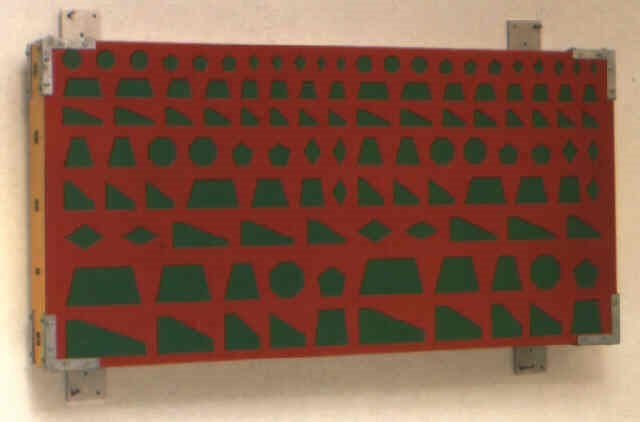“The Hot Four: Get Ready for the Next Art Stars” was the headline of New York Magazine on October 26, 1986. Paul Taylor wrote the ensuing article on the up-and-coming stars of the art scene: Ashley Bickerton, Jeff Koons, Meyer Vaisman and Peter Halley.
These four young men – all aged between 26 and 33 in 1986 – exhibited together in New York’s well-established Sonnabend Gallery in SoHo, and were lauded as the most important new discoveries of the international art scene. At the same time, they were polarizing figures, as art critic Kay Larson outlined in his follow-up to the gushing article in New York Magazine the following week, entitled “Masters of Hype”. However even this article did the artists a few favors, as they were no strangers to the “succès de scandales”. And so it should be: the collectors were in a buying frenzy, whilst exhibitions at galleries were sometimes sold out even before the previews had taken place.
The abstraction of real things
Although this was not a coherent group, but rather individual artistic personalities with varying ways of working, the Sonnabend exhibition was perceived as a style-forming group exhibition and a name was sought for the movement. Paul Taylor wrote about “Neo-Pop”, “Neo-Minimalism” and “Neo-Conceptualism”, whilst other writers called it “Smart art”, but soon the term “Neo-Geo” crystallized as an abbreviation of “Neo-Geometric”. Actually, when you look at the works of the four artists, this term only really fits the work of Peter Halley.

Bickerton, Abstract painting for people, Image via artnet.com
Halley’s works show geometric forms in bright colors, which differ from “geometric abstraction” in that they really do abstract something (and thus point to something more than simply themselves as geometric forms) and present things from the real world: images of mass production or institutionalized power, highways, prisons or circuit boards.
Canvas on toilet lids
Bickerton also abstracted things from the everyday world in his works, which looked like painted boxes and were attached to the wall with the help of metal fittings. In the work “Abstract Painting for People”, cross-sections and profiles of plumbing fixtures can be seen. Vaisman exhibited objects both on the wall and on the floor. His canvases were printed with enlargements of his own textiles. One work showed four of these printed canvases stacked on top of one another on the floor with four toilet lids on top of them, which were in turn covered in printed canvas. Jeff Koons was the only sculptor in the exhibition and exhibited well-known objects from the world of gift and bric-a-brac shops cast in stainless steel, for example an originally inflatable rabbit with a carrot.

Meyer Vaisman, The whole public thing, 1986, Image via habitatplus.com
The four artists’ works all shared the characteristic of dealing more with the images of things than with the direct objects themselves – similarly to the art of the previous style movements of “Pop art” and “Conceptual art”. In addition, the art of the “Neo-Geo”, for example, was entirely different to that of “Neo-Expressionism”, which was the style that dominated the American art world at the time.
A good business idea
Before the exhibition at Sonnabend Gallery, Bickerton, Koons, Halley and Vaisman had already exhibited in the gallery “International with Monument” on the Lower East Side, which was managed by Vaisman himself. In just a few years, the Lower East Side became a hot-spot of the New York art scene. In 1980 there were no galleries at all in the neighborhood, but little by little exhibition rooms opened in small shops that had previously been occupied by Ukrainian- or Polish-American retailers. The young gallery-owners who, like Vaisman, were often artists themselves, not only had a feel for new artistic movements but also the good business sense to open on a Sunday when the established galleries in SoHo or on 57th Street were closed. Collectors therefore started going to SoHo and 57th Street on Saturdays and then to the galleries of the Lower East Side on Sundays.

Jeff Koons, Rabbit, Image via vice.com
These collectors included the young Michael Schwartz. His parents, the collectors Eugen and Barbara Schwartz, collected “Neo-Expressionist” works, such as those of Julian Schnabel. In galleries like “International with Monument” however, Michael discovered a different type of art by artists his age, and it impressed him. He was eventually able to persuade his parents to take a look at their works and even to buy them. A crucial part of the success story, however, was art collector Charles Saatchi, who began to excessively acquire works by these young artists.
The group of the “Hot Four”
Now even established galleries like Marlborough, Mary Boone, Leo Castelli or Illeana Sonnabend wanted to put on exhibitions with artists from Vaisman’s gallery and began approaching them. Sonnabend managed to get Vaisman, Bickerton and Koons to sign a contract. Halley, who had gone to Boone shortly before, ultimately switched to Sonnabend too, so the group remained intact. And thus the “Hot Four” came to stage their group exhibition in SoHo in 1986.
